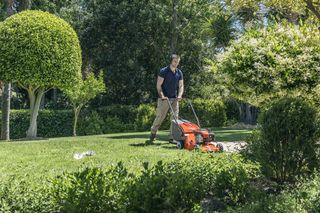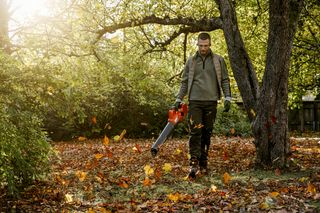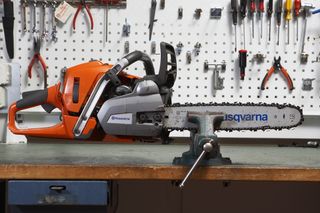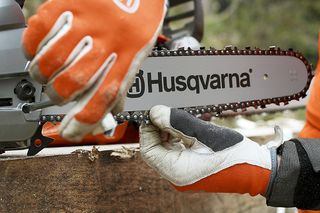
How to Lay a Perfect Lawn - Preparation, Tools and Techniques
Time to replace a tired or dying lawn? Here are our top tips and techniques for soil preparation, how to lay turf for best results and lawn aftercare.
Laying a perfect lawn is more than just simply unrolling purpose-grown turf and hoping for the best. As with everything in landscaping, putting in the proper groundwork helps ensure you’re left with a new lawn that’s as healthy, strong and green as possible - which is what everyone wants at the end of the day.
Unlike seeding with grass seed, turf cuts back on potential wastage and the time it takes for your lawn to reach maturity. The following steps will guide you from ground preparation through to maintenance and lawn aftercare - helping it reach its maximum potential and providing year after year of enjoyment.
The Best Time To Lay a New Lawn
The best time to lay turf is in mid-autumn. This is when the air is cooler and humidity is higher; helping prevent scorching and root dry-out. Of course, this means ground preparation should begin toward the end of summer to give the soil a chance to settle in before turf is laid.
Preparing to Lay Your Lawn
The actual tools you’ll need for ground preparation and aftercare will largely depend on how much prep is needed. For the purpose of this guide, we’ll assume that the lawn is being laid from scratch and cover all of the common tools you’ll need to prepare the ground before laying your lawn.
Protective Equipment
Ground preparation can be tough on the body, so using appropriate PPE is always a good idea. At the most basic level, you’ll want a decent pair of protective gloves to help minimise the risk of blisters, cuts and infection. Soil is loaded with sharp stones, sand, thorns and debris, so a good pair of sturdy boots are also a good idea. Lastly, keeping your eyes protected from dust, airborne debris and flying stones will keep you on schedule.
Removing Old Turf
To remove old or gnarly turf, a spade will usually get the job done. Simply start by creating cuts into the ground that are ½ m2, then slide the spade along the root line to loosen and remove it. If the soil beneath is extremely dry and tough, it can help to water the area generously the evening before. For removing large areas of lawn, a turf cutter can be useful.

Soil Preparation
For the best results, ensuring your soil is in as good a condition as possible creates the perfect foundations for a healthy lawn. This means removing root systems, weeds, stones, rocks and inorganic matter. If soil quality is poor it is advisable to apply a layer of top soil before laying the turf. This will help roots establish quicker and can also make levelling the ground easier.
The soil will want as much aeration as possible, which is where the Husqvarna TR 348 Tiller comes in handy. Turning soil not only incorporates air into it, but also mixes in nutrients while improving drainage. If your soil lacks nutrients, now is the time to add it into the mix. Ideally, the soil should be turned and raked twice at least 4 weeks before your turf arrives. If you have heavily compacted soil, particularly clay based, it is advisable to not only break the clay up using a Bobcat or other suitable digging tools, but also apply gypsum to further help breaking the clay down and improving aeration.
It is also important to ensure sufficient drainage has been installed prior to laying new turf. This will help avoid pooling of water on the turf during heavy rainfall.
Turf Aftercare
Once your turf is in place, it’s important not to mow it too soon after - especially if you’re using a walk-behind or ride-on mower. The easiest way to keep your lawn in tip-top condition without damaging its delicate roots is to use an Automower® 305. Automower® is a perfect choice as it is lightweight, cuts grass gently to a uniform length and returns the most tender clippings back to the soil - effectively feeding it as it goes.

How to Lay Turf the Right Way
Before you start to lay your lawn, you’ll need to know how much turf to order beforehand. Typically, turf arrives in 1m2 rolls, so measuring in m2 is the easiest way. To do this, simply measure the width of your space and then measure the length. Then multiply these to get the total amount required.
10m W x 14m L = 140m2
While it’s possible to store pre-cut turf rolls in a dark and cool spot for a few days, ideally you want to get it laid within 24-hours of delivery. This gives the roots the best shot at taking quickly and minimises areas of lawn death. If you can’t lay it for at least 5 days, give it a gentle watering every evening to prevent it from yellowing and drying out.
When laying turf on sloped ground, try to ensure that it is laid across the slope to help with moisture retention at the roots.
Laying Your New Lawn
- When you’re ready to lay your turf, the first thing to do is get some wooden planks or boards to use so you don’t place pressure on the grass as you lay it.
- Sprinkle pre-turfing fertilizer onto the soil before starting and give it a very gentle watering to around 1-2cm deep.
- Starting at the perimeter of the lawn, unroll your first turf strip (using large strips on the outside to avoid any drying out). Ensure the underside of each roll makes full contact with the soil below and firmly pat it down.
- Place the second roll of turf to the left or right of the initial roll, starting 50% up its length. Then place the third directly beneath this.
- Continue working from side to side, using a bricklaying pattern as you go.
- Ensure you create a raised lip on each edge (on all four sides) which will settle after patting down and watering and create a solid seal. Avoid pulling the turf into position and aim to create an overlap of around 2cm each time.
- When reaching edges and ends that have excess turf or are overlapping more than you need, cut the excess with a sharp kitchen knife or a lawn edger.

When to Feed & Water a New Lawn
To effectively take root, new lawns require plenty of water. How much water all depends on the time of year it’s laid. To give it a head start, give your freshly laid turf a good soaking with a hosepipe or sprinkler as soon as it’s in place. Allow the water to continue running until it has soaked through the turf and is around 2.5cm into the soil beneath. This is known as the settling soak.
If it’s not raining daily, you should continue to give your lawn a good drenching every evening for 14 days. On cooler, cloudy days; a couple of centimetres is sufficient. On hot, windy and full sun days, aim for around 10 centimetres. If you notice any browning, yellowing or dry areas, water deeply once in the morning and once in the evening.
For the first few months and over the winter, your new lawn won’t require constant feeding. However, you should aim to feed your lawn with an evenly balanced NPK fertilizer once every 6 weeks during the growing season. If using Automower® robotic lawn mower, the consistent clipping of tender blades of grass will deliver nutrition back into the ground on a regular basis.
When to Weed & Mow a New Lawn
A newly laid lawn will usually be ready for its first mowing around two to three weeks after being laid. However, you want to make sure that the roots have taken before going ahead as cutting an unrooted lawn can cause it to die. The easiest way to check for rooting is to find a corner piece of turf and gently lift it. If you feel resistance, it has rooted. If it lifts without any resistance, wait and test again in 7 days time.
You will need to monitor your lawn for weeds, and any that arise will need to be chopped or pulled to prevent them from going to seed and spreading across the lawn. If larger weeds take hold, pulling them out by hand is a better choice than applying herbicides.

Tools Designed for Professional Results
Whether you’re laying a new lawn or looking for ways to keep an established one in perfect condition, Husqvarna has your back. View our full range of cutting-edge tools online or visit your local Husqvarna dealer to explore your options, today.









